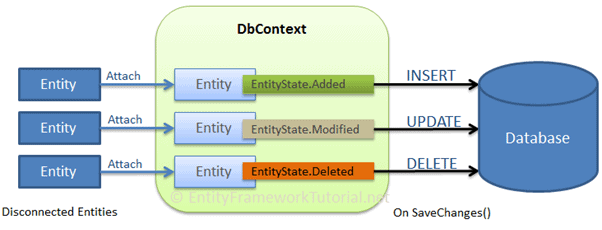Insert Data in a Disconnected Scenario in Entity Framework Core
You learned about how to save data in the connected scenario. Here, you will learn about saving data in the disconnected scenario.
Saving data in the disconnected scenario is a little bit different than in the connected scenario.
In the disconnected scenario, the DbContext is not aware of disconnected entities because entities were added or modified out of the scope of the current DbContext instance.
So, you need to attach the disconnected entities to a context with appropriate EntityState in order to perform CUD (Create, Update, Delete) operations to the database.
The following figure illustrates the CUD operations in a disconnected scenario:

As per the above figure, disconnected entities (entities which are not being tracked by the DbContext) need to be attached to the DbContext with an appropriate EntityState.
For example, Added state for new entities, Modified state for the edited entities and Deleted state for the deleted entities, which will result in an INSERT, UPDATE, or DELETE command in the database when the SaveChanges() method is called.
The following steps must be performed in order to insert, update or delete records into the DB table using Entity Framework Core in a disconnected scenario:
- Attach an entity to
DbContextwith an appropriateEntityStatee.g. Added, Modified, or Deleted - Call
SaveChanges()method
The following example demonstrates inserting a new record into the database using the above steps:
//Disconnected entity var std = new Student(){ Name = "Bill" }; using (var context = new SchoolContext()) { //1. Attach an entity to context with Added EntityState context.Add<Student>(std); //or the following are also valid // context.Students.Add(std); // context.Entry<Student>(std).State = EntityState.Added; // context.Attach<Student>(std); //2. Calling SaveChanges to insert a new record into Students table context.SaveChanges(); }
In the example above, std is a disconnected instance of the Student entity.
The context.Add<Student>() method attaches a Student entity to a context with an Added state.
The SaveChanges() method builds and executes the following INSERT statement:
exec sp_executesql N'SET NOCOUNT ON; INSERT INTO [Students] ([Name]) VALUES (@p0); SELECT [StudentId] FROM [Students] WHERE @@ROWCOUNT = 1 AND [StudentId] = scope_identity();',N'@p0 nvarchar(4000), @p1 nvarchar(4000) ',@p0=N'Bill' go
EF Core provides multiple ways to add entities with Added state. In the above example, context.Students.Add(std);, context.Entry<Student>(std).State = EntityState.Added;
and context.Attach<Student>(std); will result in the same INSERT statement as above.
Entity Framework Core provides the following DbContext and DbSet methods which attach disconnected entities with Added EntityState, which in turn will execute INSERT statements in the database.
| DbContext Methods | DbSet Methods | Description |
|---|---|---|
| DbContext.Attach | DbSet.Attach | Attach an entity to DbContext. Set Unchanged state for an entity whose Key property has a value and Added state for an entity whose Key property is empty or the default value of data type. |
| DbContext.Add | DbSet.Add | Attach an entity to DbContext with Added state. |
| DbContext.AddRange | DbSet.AddRange | Attach a collection of entities to DbContext with Added state. |
| DbContext.Entry | - | Gets an EntityEntry for the specified entity which provides access to change tracking information and operations. |
| DbContext.AddAsync | DbSet.AddAsync | Asynchronous method for attaching an entity to DbContext with Added state and start tracking it if it is not. Data will be inserted into the database when SaveChangesAsync() is called. |
| DbContext.AddRangeAsync | DbSet.AddRangeAsync | Asynchronous method for attaching multiple entities to DbContext with Added state in one go and starting tracking them if it is not. Data will be inserted into the database when SaveChangesAsync() is called. |
Note: The above DbContext methods are introduced in EF Core (they were not available in EF 6 or prior).
Both DbContext and DbSet methods perform the same operation. Which one you use depends on your coding pattern and preference.
Insert Relational Data
In the previous chapter, we learned to create one-to-one, one-to-many and many-to-many relationships between two entities. Entity Framework API inserts all the relational data contained in related entities.
Use the DbContext.Add or DbSet.Add method to add related entities to the database.
The Add method attaches entities to a context and sets the Added state to all the entities in an entity graph whose Id (Key) properties are empty, null or the default value of data type.
Consider the following example.
var stdAddress = new StudentAddress() { City = "SFO", State = "CA", Country = "USA" }; var std = new Student() { Name = "Steve", Address = stdAddress }; using (var context = new SchoolContext()) { // Attach an entity to DbContext with Added state context.Add<Student>(std); // Calling SaveChanges to insert a new record into Students table context.SaveChanges(); }
In the example above, context.Add<Student>(std) adds an instance of Student entity.
EF Core API reaches the StudentAddress instance through the reference navigation property of Student and marks EntityState of both the entities to Added,
which will build and execute the following two INSERT commands on SaveChanges().
exec sp_executesql N'SET NOCOUNT ON; INSERT INTO [Students] ([Name]) VALUES (@p0); SELECT [StudentId] FROM [Students] WHERE @@ROWCOUNT = 1 AND [StudentId] = scope_identity();',N'@p0 nvarchar(4000), @p1 nvarchar(4000) ',@p0=N'Steve' go exec sp_executesql N'SET NOCOUNT ON; INSERT INTO [StudentAddresses] ([Address], [City], [Country], [State], [StudentId]) VALUES (@p5, @p6, @p7, @p8, @p9); SELECT [StudentAddressId] FROM [StudentAddresses] WHERE @@ROWCOUNT = 1 AND [StudentAddressId] = scope_identity(); ',N'@p5 nvarchar(4000),@p6 nvarchar(4000),@p7 nvarchar(4000),@p8 nvarchar(4000), @p9 int',@p5=NULL,@p6=N'SFO',@p7=N'USA',@p8=N'CA',@p9=1 Go
Insert Multiple Records
Use the DbContext.AddRange or DbSet.AddRange method to add multiple entities in one go.
You don't need to call DbContext.Add method multiple times.
| AddRange Methods | Description |
|---|---|
void AddRange(IEnumerable<Object> entities)
|
Adds a list of same or different types of entities to the DbContext with Added state. |
void AddRange(param object[] entities)
|
Adds an array of same or different types of entities to the DbContext with Added state. |
void AddRangeAsync(IEnumerable<Object>, CancellationToken)
|
Asynchronous method to add a list of same or different types of entities to the DbContext with Added state. |
The following example demonstrates adding a list of Student entity objects using AddRange.
var studentList = new List<Student>() { new Student(){ Name = "Bill" }, new Student(){ Name = "Steve" } }; using (var context = new SchoolContext()) { context.AddRange(studentList); context.SaveChanges(); }
The above example will insert two new records in the Students table.
You can also add a list of different types of entities, as shown below.
var std1 = new Student(){ Name = "Bill" }; var std2 = new Student(){ Name = "Steve" }; var computer = new Course() { CourseName = "Computer Science" }; var entityList = new List<Object>() { std1, std2, computer }; using (var context = new SchoolContext()) { context.AddRange(entityList); // or // context.AddRange(std1, std2, computer); context.SaveChanges(); }
In the above example, entityList is a type of List<Object>. So, it can contain any type of entities.
The AddRange() method adds all the specified entities to a context and SaveChanges() will build and execute INSERT statements for all in one go.
EF Core improves the performance by executing INSERT statements for all the above entities in a single database round trip. The above example will execute the following statements in the database.
exec sp_executesql N'SET NOCOUNT ON; INSERT INTO [Courses] ([CourseName], [Description]) VALUES (@p0, @p1); SELECT [CourseId] FROM [Courses] WHERE @@ROWCOUNT = 1 AND [CourseId] = scope_identity(); DECLARE @inserted1 TABLE ([StudentId] int, [_Position] [int]); MERGE [Students] USING ( VALUES (@p2, 0), (@p3, 1)) AS i ([Name], _Position) ON 1=0 WHEN NOT MATCHED THEN INSERT ([Name]) VALUES (i.[Name]) OUTPUT INSERTED.[StudentId], i._Position INTO @inserted1; SELECT [t].[StudentId] FROM [Students] t INNER JOIN @inserted1 i ON ([t].[StudentId] = [i].[StudentId]) ORDER BY [i].[_Position]; ',N'@p0 nvarchar(4000),@p1 nvarchar(4000),@p2 nvarchar(4000),@p3 nvarchar(4000)', @p0=N'Computer Science',@p1=NULL,@p2=N'Steve',@p3=N'Bill' go
Insert Data Using DbSet
As mentioned before, you can use DbSet to save an instance of an entity which will be translated into INSERT/UPDATE/DELETE command in the database, in the same way as EF 6.x.
Use the DbSet<TEntity>.Add() method to attach an entity with Added state or the DbSet<TEntity>.AddRange() method to attach a collection of entities with Added state, as shown below.
var std = new Student() { Name = "Bill" }; using (var context = new SchoolContext()) { context.Students.Add(std); // or // context.Students.Attach(std); context.SaveChanges(); }
In the above example, the type of context.Students is DbSet<Student> type.
So, we can only add the Student entity. The context.Students.Add(std) attaches the Student entity to the context with the Added state, which will result in the INSERT statement when the SaveChanges() method is called.
Learn how to update disconnected entities in the next chapter.
